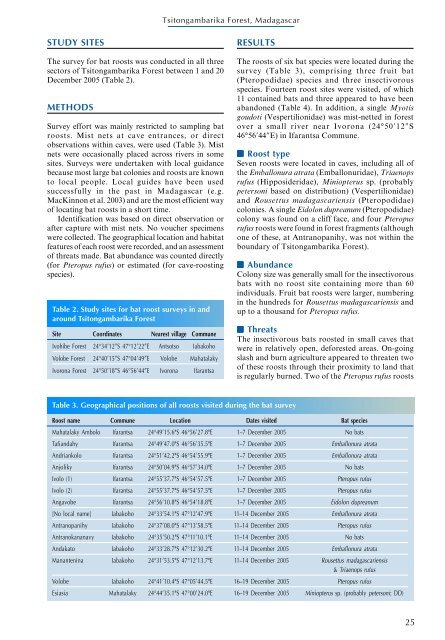TSITONGAMBARIKA FOREST, MADAGASCAR - BirdLife International
TSITONGAMBARIKA FOREST, MADAGASCAR - BirdLife International
TSITONGAMBARIKA FOREST, MADAGASCAR - BirdLife International
Create successful ePaper yourself
Turn your PDF publications into a flip-book with our unique Google optimized e-Paper software.
STUDY SITES<br />
The survey for bat roosts was conducted in all three<br />
sectors of Tsitongambarika Forest between 1 and 20<br />
December 2005 (Table 2).<br />
METHODS<br />
Survey effort was mainly restricted to sampling bat<br />
roosts. Mist nets at cave entrances, or direct<br />
observations within caves, were used (Table 3). Mist<br />
nets were occasionally placed across rivers in some<br />
sites. Surveys were undertaken with local guidance<br />
because most large bat colonies and roosts are known<br />
to local people. Local guides have been used<br />
successfully in the past in Madagascar (e.g.<br />
MacKinnon et al. 2003) and are the most efficient way<br />
of locating bat roosts in a short time.<br />
Identification was based on direct observation or<br />
after capture with mist nets. No voucher specimens<br />
were collected. The geographical location and habitat<br />
features of each roost were recorded, and an assessment<br />
of threats made. Bat abundance was counted directly<br />
(for Pteropus rufus) or estimated (for cave-roosting<br />
species).<br />
Table 2. Study sites for bat roost surveys in and<br />
around Tsitongambarika Forest<br />
Site Coordinates Nearest village Commune<br />
Ivohibe Forest 24°34’12”S 47°12’22”E Antsotso Iabakoho<br />
Volobe Forest 24°40’15”S 47°04’49”E Volobe Mahatalaky<br />
Ivorona Forest 24°50’18”S 46°56’44”E Ivorona Ifarantsa<br />
Tsitongambarika Forest, Madagascar<br />
RESULTS<br />
Table 3. Geographical positions of all roosts visited during the bat survey<br />
The roosts of six bat species were located during the<br />
survey (Table 3), comprising three fruit bat<br />
(Pteropodidae) species and three insectivorous<br />
species. Fourteen roost sites were visited, of which<br />
11 contained bats and three appeared to have been<br />
abandoned (Table 4). In addition, a single Myotis<br />
goudoti (Vespertilionidae) was mist-netted in forest<br />
over a small river near Ivorona (24°50’12”S<br />
46°56’44”E) in Ifarantsa Commune.<br />
■ Roost type<br />
Seven roosts were located in caves, including all of<br />
the Emballonura atrata (Emballonuridae), Triaenops<br />
rufus (Hipposideridae), Miniopterus sp. (probably<br />
petersoni based on distribution) (Vespertilionidae)<br />
and Rousettus madagascariensis (Pteropodidae)<br />
colonies. A single Eidolon dupreanum (Pteropodidae)<br />
colony was found on a cliff face, and four Pteropus<br />
rufus roosts were found in forest fragments (although<br />
one of these, at Antranopanihy, was not within the<br />
boundary of Tsitongambarika Forest).<br />
■ Abundance<br />
Colony size was generally small for the insectivorous<br />
bats with no roost site containing more than 60<br />
individuals. Fruit bat roosts were larger, numbering<br />
in the hundreds for Rousettus madagascariensis and<br />
up to a thousand for Pteropus rufus.<br />
■ Threats<br />
The insectivorous bats roosted in small caves that<br />
were in relatively open, deforested areas. On-going<br />
slash and burn agriculture appeared to threaten two<br />
of these roosts through their proximity to land that<br />
is regularly burned. Two of the Pteropus rufus roosts<br />
Roost name Commune Location Dates visited Bat species<br />
Mahatalaky Ambolo Ifarantsa 24°49’15.6"S 46°56’27.8"E 1–7 December 2005 No bats<br />
Tafiandahy Ifarantsa 24°49’47.0"S 46°56’35.5"E 1–7 December 2005 Emballonura atrata<br />
Andriankolo Ifarantsa 24°51’42.2"S 46°54’55.9"E 1–7 December 2005 Emballonura atrata<br />
Anjoliky Ifarantsa 24°50’04.9"S 46°57’34.0"E 1–7 December 2005 No bats<br />
Ivolo (1) Ifarantsa 24°55’37.7"S 46°54’57.5"E 1–7 December 2005 Pteropus rufus<br />
Ivolo (2) Ifarantsa 24°55’37.7"S 46°54’57.5"E 1–7 December 2005 Pteropus rufus<br />
Angavobe Ifarantsa 24°56’10.8"S 46°54’18.8"E 1–7 December 2005 Eidolon dupreanum<br />
[No local name] Iabakoho 24°33’54.1"S 47°12’47.9"E 11–14 December 2005 Emballonura atrata<br />
Antranopanihy Iabakoho 24°37’08.0"S 47°13’58.5"E 11–14 December 2005 Pteropus rufus<br />
Antranokananavy Iabakoho 24°35’50.2"S 47°11’10.1"E 11–14 December 2005 No bats<br />
Andakato Iabakoho 24°33’28.7"S 47°12’30.2"E 11–14 December 2005 Emballonura atrata<br />
Manantenina Iabakoho 24°31’53.5"S 47°12’13.7"E 11–14 December 2005 Rousettus madagascariensis<br />
& Triaenops rufus<br />
Volobe Iabakoho 24°41’10.4"S 47°05’44.5"E 16–19 December 2005 Pteropus rufus<br />
Esiasia Mahatalaky 24°44’35.1"S 47°00’24.0"E 16–19 December 2005 Miniopterus sp. (probably petersoni; DD)<br />
25

















